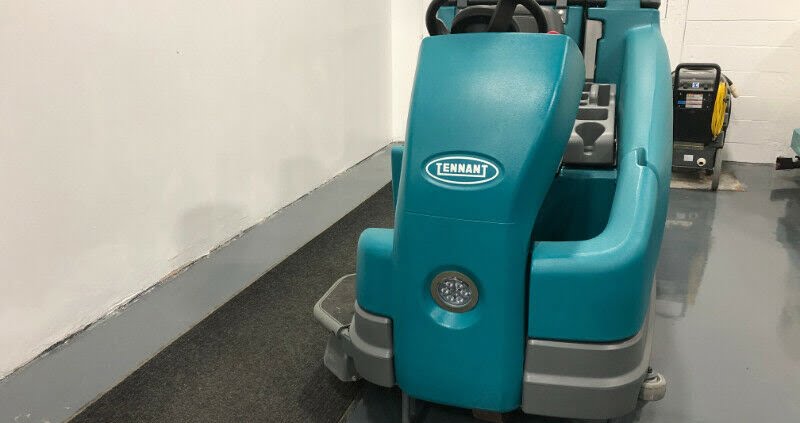Considering the cost benefits, switching to a commercial floor cleaning machine simply makes good business sense.
Did you know? Labour costs can account for up to 85% of your facility’s cleaning costs.
Cleaning is one of the most labour intensive tasks in any commercial or industrial facility. That’s why it’s important to get the very most out of every cleaning shift without increasing your labour expenses. Whenever possible. It’s also why the switch to a commercial floor cleaning machine pays for itself in a very short time. High-quality floor cleaning machines – industrial floor scrubbers and sweepers – ensure that your cleaning team can maximize their cleaning time and effort during their shifts.
Commercial floor cleaning machines help you reduce the labour time of your cleaning staff. They can also help you reassign your cleaning team to other important cleaning tasks, particularly on the heels of a global pandemic, to focus on other high-touch and high-traffic areas of concern around your facilities. They provide a great way for you to enjoy thorough, consistent cleaning capabilities as you enhance the safety of your cleaning staff while at work.
The question then becomes, “How much does a commercial floor cleaning machine cost?” or, for many owners and managers, “Can we afford to invest in an industrial machine?” And while a machine is certainly more expensive than its manual counterparts, good cleaning equipment can provide your business with big savings through lower labour, chemical, and water costs.
It’s all about the return on investment or ROI.
How to calculate the ROI of an industrial floor cleaning machine?
Various factors are required to calculate the specific ROI of your floor cleaning equipment purchase, so it can be challenging. Answer these seven questions to help you calculate more accurately:
How much square footage needs to be cleaned? Measure the exact amount of space to clean – consider obstacles like desks, file cabinets, and any other obstructions in the cleaning path. For example, yours may be a 30,000 square foot facility, but the specific square footage of the floor that will be cleaned may only amount to about 15,000 square feet when you consider any furnishings, fixtures, or other items.
How often do you need to clean? The next important factor is the frequency of floor cleaning you require. To estimate this, you need to look at the amount of traffic your spaces experience and the amount of dirt and soil that typically collects. Some facilities may only need a daily floor cleaning, while others may need to clean their floors more frequently to maintain a clean and tidy appearance. As you calculate, keep in mind holidays and weekends, those days when your facilities are empty.
What is the average amount of time it takes to complete the cleaning the way you’re doing it now? You need to know how much you spend on labour, equipment, and materials annually the way your team is cleaning currently. This will help you calculate the potential savings on labour if you upgrade to a new machine. How many man-hours are required to clean the square footage of your facility? How frequently do you currently clean? Include this number in your calculations.
What is your loaded labour cost? To calculate an employee’s loaded labour cost, you have to include everything you have to pay for them to complete one hour of work. This is more than just the employee’s hourly wage. You have to also include taxes, benefits, liability insurance, and other costs related to their work. To calculate an accurate ROI on a floor cleaning equipment purchase, you must account for every cost associated with that employee’s time.
What will be your average use of water and chemicals? The cost of floor cleaning includes the cost of water and cleaning chemicals and depends on the machine used, the square footage to clean, rework, and the water and chemical costs for your facility. Industrial floor scrubbers, for instance, use significantly less water than conventional floor cleaning. With less water usage, you’ll likely also see a reduction in cleaning chemical use.
What will be the period to pay off the machine? To identify how long it will take you to pay off your investment, make back the amount of your purchase, you’ll need to know the total estimated savings you will generate annually. After you’ve paid back the initial amount, your investment will begin to save you money. To calculate, add up your savings in labour, chemicals, water, and cleaning frequency.
What is the estimated lifespan of the equipment you’re considering? With the help of your retailer, identify the estimated lifespan of the machine of interest to you. Once you know the lifespan, you can multiply your annual savings by the number of years you expect the machine to last.
Determine your floor cleaning machine ROI
To calculate the final ROI of your equipment purchase, subtract the cost of the machine from the estimated savings over the lifespan of your industrial floor cleaning machine. That number will identify how much your machine will provide as a return on your investment. For instance, (lifetime savings) – (equipment cost) = ROI.
Industrial floor cleaning machines for sale or lease in Ontario
Industrial floor cleaning machines are an easy, efficient, ecologically friendly floor cleaning solution. The best way to keep your facility floors clean and disinfected. And they pay for themselves quickly.
Let us help you find the best cleaning machine for your business! We carry ride-on floor machines and walk behind, new, refurbished, and for lease. Find out what’s best for you.
SAVE time and SAVE money with KwikFix Depot! CONTACT US to find out more!




